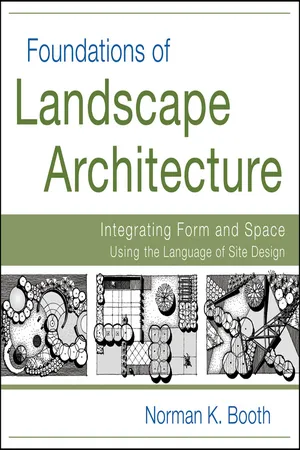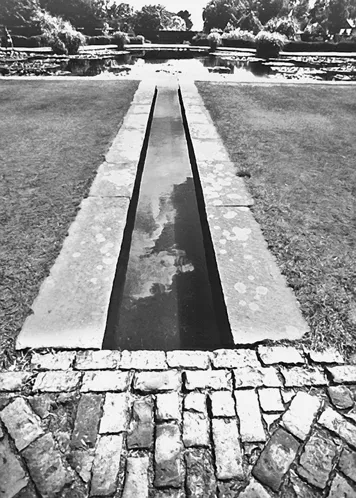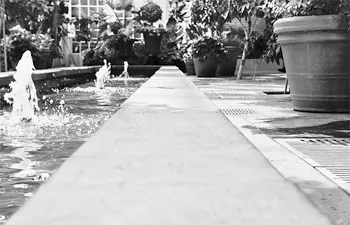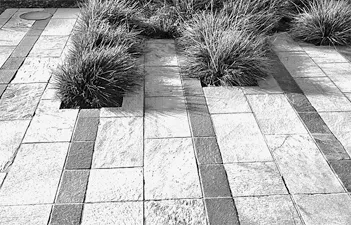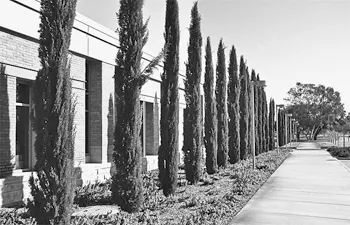![]()
Orthogonal Forms
Chapter 3
The Straight Line
The discussion of orthogonal forms begins with the straight line or vector, the most fundamental component of all flat-sided forms. The straight line is the elementary component from which the square, rectangle, and other orthogonal forms are created. The sides, internal axes, and implied internal grid of the square and rectangle are all straight lines placed at right angles to one another. The straight line is also integral to the grid, symmetrical, and asymmetrical organizational structures composed of multiple squares and rectangles. In all its potential variations, the straight line is the basis for shaping a landscape that possesses clearly articulated edges and a human, architectonic design character.
While the straight line is integral to all orthogonal geometries, the focus of this chapter is on the straight line as a singular design element that has its own unique qualities and uses as an organizing element in landscape architectural site design. This chapter reviews inherent qualities, possible uses, and associated guidelines for employing the straight line as a principal design element in molding landscape space. The sections of this chapter include:
- Fundamental Characteristics
- Landscape Uses
- Design Guidelines
Fundamental Characteristics
A line is a design element whose length far exceeds its width, thus giving it the perception of being a one-dimensional element. While all physical objects must actually possess two dimensions, a line is nevertheless a proportionally narrow entity that occupies a relatively thin area over a protracted distance. The straight line is distinguished from other lines like the diagonal, arch, or curvilinear line by virtue of connecting two points in the shortest distance. The straight line is an expression of efficiency, decisiveness, and uninterrupted movement.
The straight line is primarily a human construct, although examples of direct lines are seen in redwood trunks and other similarly structured trees, stratification of rocks, the distant horizon of a large body of water, parts of flowers, and so on. In the human landscape, the straight line is created by any extended, narrow two-dimensional element such as a walk, road, channel of water, and band of a pavement material or by a thin three-dimensional object like a fence, wall, and hedge (3.1). In addition, a straight line is implied by a continuous row of individual elements like trees, columns, lights, and flagpoles.
Landscape Uses
The straight line's one-dimensionality, directness, simplicity, and continuity serve as the basis for numerous uses in landscape architectural site design. While separated here for clarity of explanation, many of these functions are mutually reinforcing and occur simultaneously with each other giving the straight line the ability to accomplish a number of design objectives at once. Potential landscape uses of the straight line are: direct the eye, accommodate movement, establish a datum, establish a dividing edge, provide an architectural extension, imply human control, and create rhythm.
Direct the Eye
All lines in the landscape capture and direct the eye although the straight line does this most emphatically (3.1–2). The straight line's uninterrupted, extended length seizes the eye to lead it to an end point or notable interruption on the line. This is most obvious when one is located directly on the line or next to the line looking along its length (3.3). A straight line is less directional when viewed from the side. The straight line's directionality is most apparent when it is reinforced in the third dimension by parallel vertical planes of buildings, walls, or plants (3.4). The vertical planes function like blinders to constrain one's attention along the corridor space to the termini. This is one of the most forceful visual experiences in the landscape and should be employed only in situations where such unequivocal focus is warranted.
Similar to the rectangle, the line's termini should be appropriately accentuated because of the concentrated visual focus on them (3.5). This is especially so when the straight line is integral to a linear space. A sculpture, significant building, water feature, special plant, framed view, or any noteworthy element can potentially serve as the accent at the end points (3.6). The accumulated energy of the straight line is unnecessarily dissipated when the terminus lacks a focal point.
Movement
Besides directing visual attention, paved lines can be arteries of physical movement through the landscape (3.7). The straight line supports efficient, unequivocal, controlled, and authoritative passage along its protracted length. ...
